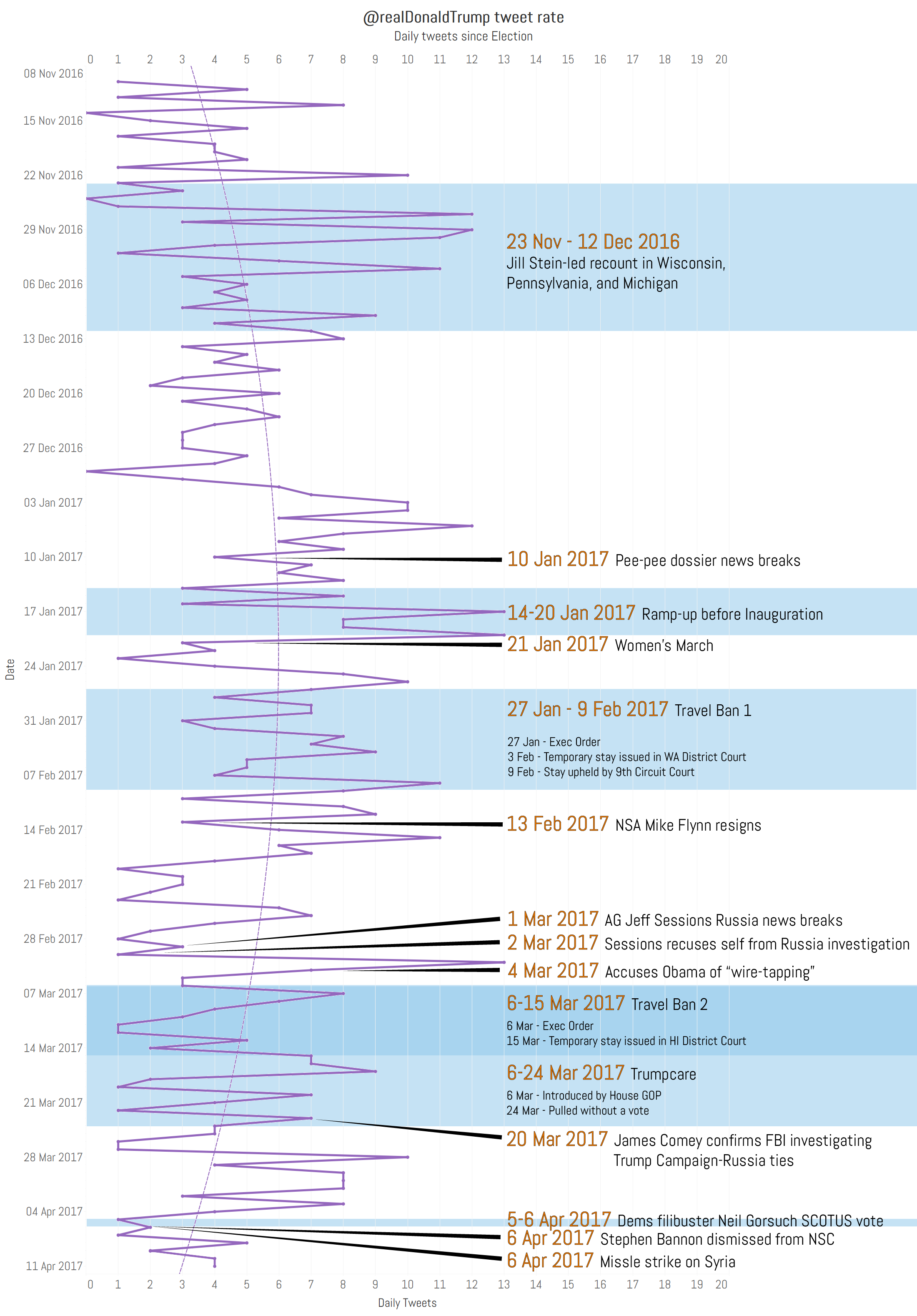By: Patrick W. Zimmerman
The question
The Eagle’s Nest spurts 140 character pearls of wit in fits and starts. We’ve pretty extensively tracked Trump’s twitter targets, most significant terms, and Doomsday insults, but have yet to really focus in on what and when the tweets fly. Some days (ok, 3 days in the last 151), @realDonaldTrump is silent, pensively clasping tiny hands and writhing in the throes of writers’s block. Other days, 10, 12, 13 tweets come rushing out in a torrent of bluster, denial, and confusion. The purpose of the Trump Watch is to bring order to this chaos. To see if there is any signal in all that noise.
Is there any pattern to how frequently he tweets?
The short-short version
The Donald seems to have very little method to his madness if looking for day-to-day causality, other than a lower tweet rate on Mondays.
However, if you map specific news stories onto a timeline of his tweet rate, then he exhibits a tendency to go relatively quiet in the immediate aftermath of major scandals, then sally with a blitz a few days later (there are several exceptions to this pattern, though).
The overall trend is that there was a clear spike in activity in January and February, and that he’s been more inclined to reign things in since about Valentine’s Day (just after NSA head Mike Flynn resigned).
The timeline
Examples of Trump’s pattern of delayed tweetstorms
I’ve taken our Trump Watch database and plotted the daily tweet rate dating back to just after the election and compared the ebb and flow of his Twitter habit to the pace of the (numerous) newsworthy scandals that our Dear Leader has been faced with since then.
At first glance there seems to be little rhyme or reason to Trump’s tweeting. Or to the variance in its frequency. If you look a little closer, however, you can start to see an occasional pattern. When something Trump doesn’t like hits the news, he often ignores it for a day or two before his itchy Twitter fingers get the best of him and he starts rage-tweeting about either a) the incident or b) something that he hopes will distract everyone from the incident.
Some examples of this pattern:
- The Women’s March: Between 3.2 and 5.2 million protesters hit the streets the day after an inauguration featuring a famously sparse crowd of some 160,000. Trump’s response? He went from a sample-high of 13 tweets per day in the build up to his inauguration to the Twitter equivalent of crickets chirping (12 tweets over the next 4 days combined). After that pause, he tried to sign an executive order every 5 minutes for about a week, lashing out via Twitter at anyone who would dare object.
- Mike Flynn’s resignation: Flynn resigned on the 13th of February after having been exposed lying about his connections to the Russian ambassador, and the 13th and 14th were relatively low volume days. Then, on the 15th, Trump was back above double-digits lambasting the “fake news media” for pushing the Russia story, the leakers for betraying him, and Obama for having been weak on Russia.
- Jeff Sessions recuses himself: After Sessions became the second member of the cabinet to have lied about talking to the Russians on March 1st, he recused himself from involvement in the DoJ’s investigation a day later. @realDonaldTrump is quiet on the 1st (3 tweets) and the 2nd (1 tweet), but from the weekend sanctuary of Mar-a-Lago goes off on a blistering invective against the Democrats, defending Sessions, and accusing his predecessor of wiretapping Trump Tower after watching too much TV.
- The collapse of Trumpcare: The AHCA, which Trump personally campaigned hard for in Washington, was to be his first major piece of legislation. From its introduction on March 6th through its final humiliating pull without even a vote on the 24th, Trump was greasing palms and issuing threats. Including the day of its collapse, he only issued 10 tweets over 4 days before matching that total on March 28th alone, lashing out at the conservative wing of his own party as well as his favorite targets, the Democrats and the fake news media.
Some exceptions to this pattern:
- Travel Ban 1: The Donald insulted pretty much the entire judicial system in real time as first Brooklyn, then Washington, then the 9th Circuit Court of Appeals blocked the execution of his executive order banning all travel into the US for citizens of 7 Muslim-majority countries. No pause here.
- The James Comey hearings: When FBI director spoke before the House Intelligence Committee on March 20th, Trump effectively gave a livestream, tweeting his skewed interpretation of Comey’s testimony during the event. This led to one of the more surreal moments of the proceedings, when Comey corrected Trump’s tweets about what Comey had said later in the same hearing.
The full dashboard
For those of you wanting detailed, day-by-day stats on @realDonaldTrump’s twitter habits. Yes, I know you’re out there.
What next?
The big question is whether or not this latest drop in Tweet frequency, coinciding with Steve Bannon’s possibly-temporary fall from influence, will stabilize as the new, less off-the-cuff Donald, or whether it’s a temporary blip in his behavior. If Ivanka, Jared Kushner, and the “adults-in-the-room” faction of the administration remain in the ascendant for any significant stretch of time, they might actually be able to get Donald to put away his phone. Occasionally.
If, on the other hand, Trump likes his administration as a constantly churning ball of chaotic backstabbing competition, then whomever is next tabbed as that week’s (or month’s) favorite might turn back on the Twitter faucet.
Stay tuned.



No Comments on "The tweet rate monitor: Is there any rhythm to Trump’s twitter blasts?"